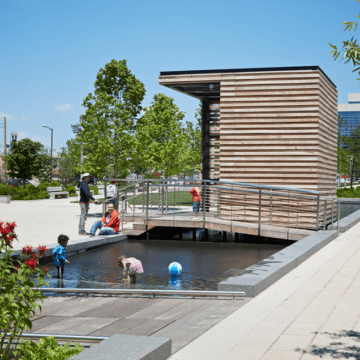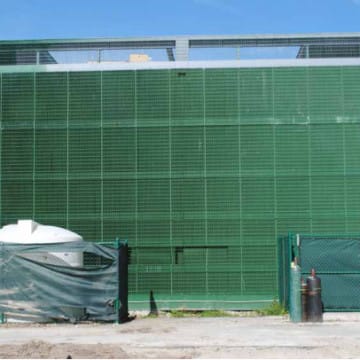Penn Park
Penn Park has transformed an unappealing “leftover space” into an active part of the University of Pennsylvania campus and a green visual connection to Center City Philadelphia. The university developed the park as part of the Penn Connects master plan, and its innovative green infrastructure goes beyond the city of Philadelphia’s Green City, Clean Waters plan requirements for stormwater absorption. The stormwater management features not only serve an environmental function, but also contribute to the park’s sense of place while presenting research and educational opportunities. “It’s a natural environment in what we all remember as a vast and inaccessible Postal Service parking and storage yard,” says university architect David Hollenberg. “It really is an incredible thing.”
Context
The University of Pennsylvania acquired the Penn Park site primarily from the U.S. Postal Service (USPS). The park site was part of a larger surplus property disposal deal with the USPS, when the agency downgraded its landholdings in Philadelphia. The park site was previously used for a vehicle maintenance facility and parking lot and included or bordered a web of infrastructure, including a high-speed-rail track, a commuter-train line, freight-train tracks, and two major downtown connections.
USPS disposed of its 30th Street holdings as one parcel rather than subdividing contiguous properties. The university retained and developed the open parking and storage component of the disposed properties as Penn Park. For the remainder, the university entered into a ground lease arrangement with Brandywine Realty Trust, which has constructed a residential tower, a garage rooftop park, and the mixed-use corporate FMC Tower. Finally, the historic circa 1930 post office was fully turned over from Penn to the trust, which has restored and rehabilitated it for use as offices for the Internal Revenue Service.
The new park would support adjacent recreational and athletic facilities and also presented the opportunity to innovate with water management. “Penn Park was one of a handful of early examples of following Philadelphia Water’s stormwater regulations,” explains Hollenberg. “We were a big and visible early example of the kind of stormwater management the Philadelphia Water Department wanted to implement.” The design of the park would also respond to the university’s first Climate Action Plan, which included water management objectives. In addition, a separate Stormwater Management Plan explored possible sites, tools, and best practices for the entire campus.
“We could manage our stormwater requirements on campus by putting everything out of sight and underground. But we recognize that the rain gardens and the visible green roofs are a way to convey to people that we are taking water seriously even to the extent of introducing new landscape typologies to the campus.” – David Hollenberg, University Architect, University of Pennsylvania
Today, Penn Park includes passive park space, two multipurpose turf fields, 12 tennis courts, a natural-grass hockey field, a softball field, concessions space, a press box, spectator stands, a food orchard, and a student-run apiary. The entire park is open to the public, and community members can rent field and recreational space. Sculptural landforms connect the different functions and grade levels, creating a pedestrian circulation network that showcases the historic infrastructural forms remaining—in particular, the CSX train trestle overhead, still in active use on the site.
Innovative Water Management Features
- Bioswales, rain gardens, and meadows. The park can reclaim about an inch and a half of rainwater. Natural features of the park designed to capture stormwater include meadow plantings, bioswales that cover roughly three-quarters of an acre, and nearly 570 newly planted trees. The meadow aesthetic was new to the campus.
- Cistern and associated underground infrastructure. An underground 300,000-gallon cistern collects runoff from the adjacent turf athletic fields, which are porous and collect roughly 2 million gallons of stormwater per year. In the first five years of use, the cistern has never needed to be emptied manually on account of filling to capacity. The park also includes further underground infrastructure to accommodate its location: for example, an underground support system ensures that the weight from the berms and meadow plantings is evenly distributed and does not disrupt the adjacent rail line.
Value Proposition
The park has helped the university achieve some of its masterplanning goals, creating new open space and better connecting the campus and the community. Today, the park hums with activity and offers commuters a scenic link across a previously fenced-off, inaccessible site. The park has also become a site for student and faculty environmental research and pilot projects such as the orchard and apiary. Faculty members and students are continuing to identify new opportunities for on-site research and are currently looking into adding groundwater monitoring wells. A first test of the park’s water management mechanisms came in 2011 in the month before the ribbon-cutting, when Philadelphia experienced 13.6 inches of rain, a city record for rainfall in a
month. Shortly afterward, Hurricane Irene brought nearly six inches of rainfall in 12 hours, bringing the Schuylkill River to its highest level in 140 years. University president Amy Guttman notes that “our state-of-the-art drainage system had obviously worked. . . . It was put to the ultimate test with Irene far sooner than we could have expected, and it passed with flying colors.”
Lessons Learned
Maintenance required a significant learning curve. The water-rich bioswales of Penn Park, as well as the monitoring systems in place, were new to the campus and initially presented challenges to the university’s grounds crew. “It’s a full-time job to keep it managed and operated,” explains Bob Lundgren, the university landscape architect. “We’re always learning more.” Challenges have included:
- Monitoring systems. Instruments that measure the dryness and wetness of soil require fluency with the system for all involved. “It’s great to have a smart system, but you have to remember to turn things on and off, and if you don’t reboot it, it’s not going to work,” explains Lundgren, recounting an instance when a stuck-open valve led to significant water loss.
- Bioswale and meadow landscapes. Bioswales, which hold water and allow it to seep into the earth, require a very different maintenance approach from grass surfaces. Penn Park’s bioswales sit within a meadow, featuring a range of upland plantings. When disturbances occur and soils erode, weeds can become prevalent and spread, which is a particular challenge for the university, given policies against pesticides or herbicides.
- Deicing. The university uses EnvironMelt, a less caustic deicing material, instead of rock salts that might contaminate the water in the cistern.


